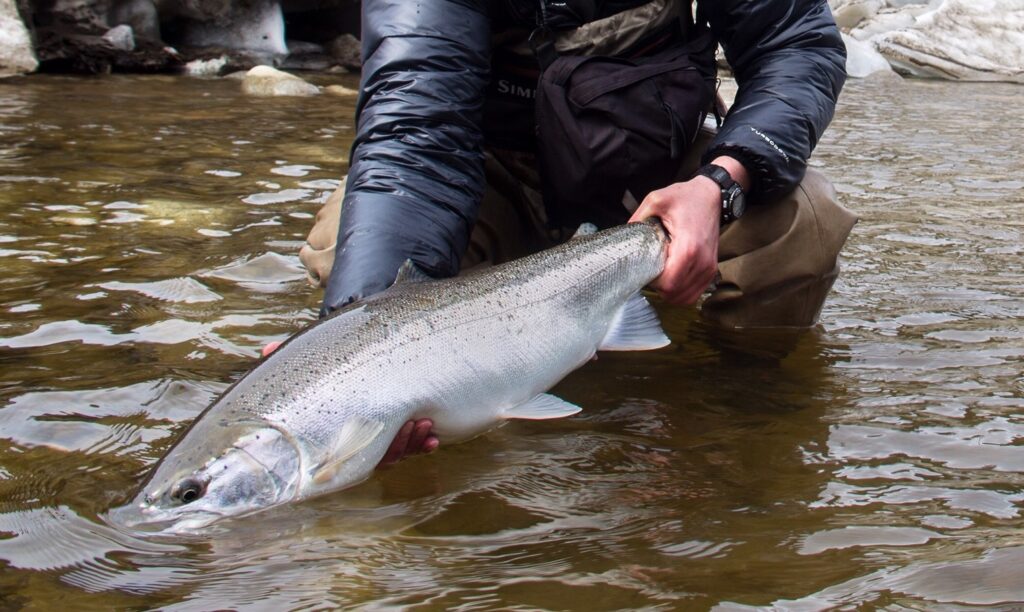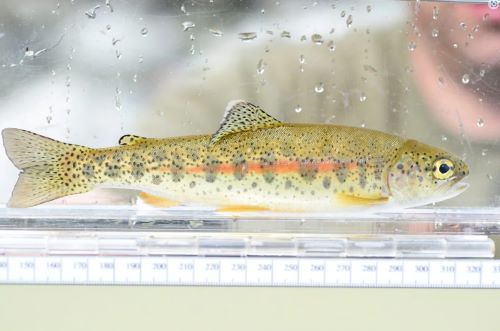What motivates a trout to migrate to the ocean or stay put in its stream has been a question that has perplexed fish scientists for decades. Fish migrate to the sea for one main reason – the groceries. Marine environments provide a much richer food source than freshwater, and fish grow big. As with most animals, size matters. Body size equates to selective advantage in terms of reproductive potential and contributing to the next generation. Large males may be more successful in seeking mates and fending off other males. Large females produce more eggs.
Same species – different life strategies
Pacific salmon tend to be “fixed” in their life strategy. In the majority of cases, chum, pink, sockeye, coho, and chinook migrate to the ocean, where they grow to adults before returning to fresh water to spawn; they spawn only once.
Coastal streams also contain sea-run populations of trout, including steelhead, coastal cutthroat, Dolly Varden, and even bull trout. However, not all trout migrate, even where they can access the ocean, and many spawn multiple times over their lives. For example, some individuals (predominantly males) retain juvenile features as parr that never leave fresh water, and still manage to breed with females. “Sneaky males” is a term commonly used to refer to these individuals because they dart in around the large males to get access to the females. In other cases, where trout can access large rivers or lakes, they may migrate to these locations to feed and mature rather than to the ocean.
Scientists have been aware of different life strategies for decades, and sometimes identified them as different species. For example, searun steelhead trout were thought to be a different species from freshwater rainbow trout (which they are not). Furthermore, it was generally believed that offspring followed the same life strategy as their parents. In other words, if your parent was a steelhead, then you would be too.
Adopting a migratory or resident lifestyle
However, recent research indicates that the “decision” to stay or go is more complicated than simply doing what your parents did. It appears that in many streams containing both steelhead and rainbow trout, offspring may be capable of adopting either a migratory or a resident lifestyle. This “choice” appears to be influenced by the environment (e.g. water temperature) and individual physical condition (e.g. growth). Genetics (i.e. inherited traits) also has a role, but how much is thought to depend on the population.
Employing a diversity of life-strategy options
The term “hedge betting” is commonly used in the financial world meaning to protect against loss by supporting more than one possible outcome. In recent years, this same term has been applied to trout populations that may follow different life strategies in response to different conditions. Compared to naturally prolific salmon species that hedge their bets on survival with the production of large numbers of adults (ranging from thousands to millions), trout populations are relatively small (ranging only from hundreds to thousands).
Trout hedge their bets instead by employing a diversity of life-strategy options to ensure that some individuals make it to the next generation. If ocean conditions are good, sea migration (anadromy) is a good bet. When ocean conditions are poor, staying put in fresh water (residency) means trout stand a better chance of surviving, even if they don’t grow as large or produce as many eggs. While an individual fish can’t predict what’s happening in the ocean or make a choice based on that, maintaining different options ensures that some individuals in a population should always survive to reproduce. This has been an effective strategy over the millennia to ensure the survival of the species even in the face of variable and often adverse conditions.


Is resiliency enough to maintain future trout populations?
This begs the question: is this strategy enough to maintain populations in light of the dramatic environmental shifts we are now experiencing, in addition to the cumulative impacts of resource extraction and development on the landscape? Fewer fish migrating to sea does not necessarily equate to an increase in the production of resident fish. The freshwater habitat has limitations on how many fish it can support, and these limitations will be affected by impacts such as water withdrawal, droughts, rising temperatures, as well as habitat degradation.
Understanding what influences migration is fundamental to managing partially migrating trout populations, particularly in the face of climate change and the massive declines in sea-run trout numbers like that witnessed for the high-profile Thompson River steelhead. Trout have proven to be highly resilient, with unexpected recoveries occasionally reported where a population was thought to have gone extinct or close to it. However, resiliency can only go so far.
References
Kendall, N.W., J.R. McMillan, M.R. Sloat, T.W. Beuhrens, T.P. Quinn, G.R. Pess, K.V. Kuzishchin, M.M. McClure and R.W. Zabel. 2015. Anadromy and residency in steelhead and rainbow trout (Oncorhynchus mykiss): a review of the processes and patterns. Can. J. Fish. Aquat. Sci. 72:391-242.
Sloat, M.R. and G.H. Reeves. 2014. Individual condition, standard metabolic rate, and rearing temperature influence steelhead and rainbow trout (Oncorhynchus mykiss) life histories. Can. J. Fish.Aquat. Sci. 71:1-11.
Author: Sue Pollard, Freshwater Fisheries Society of BC
Original publish date: October 24, 2018